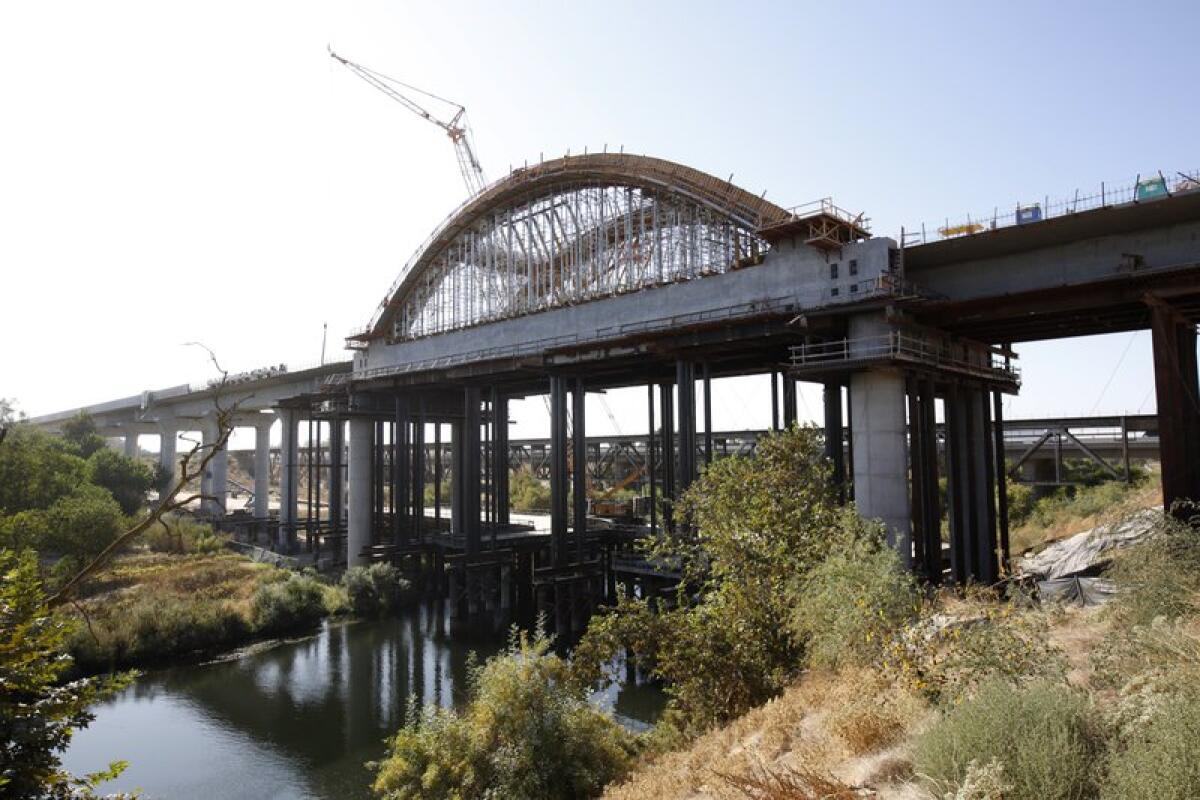High-speed rail to run on a single track in Central Valley as overall cost rises

The first phase of the California bullet train — a 171-mile link in the Central Valley — will be reduced to a single track as its estimated cost has risen by $2 billion, according to a revised business plan for the project released Tuesday.
The California High Speed Rail Authority said it would not install two tracks on the Bakersfield-to-Merced route, as previously planned. The rail authority expects to save $1.1 billion on the eliminated track, according to the business plan, though it will ultimately depend on the bids it receives on future contracts.
The new plan also estimates that the full cost of building the full Los Angeles-to-San Francisco system could reach $100 billion, up from an estimated $98 billion a year ago. The rail authority continues to project a mid-2030s startup, despite a massive $80-billion funding gap to actually build the full line.
“Building the nation’s first truly high-speed rail system linking the Bay Area to Los Angeles and Anaheim, including the communities in the Central Valley, is essential for California,” Brian Kelly, the authority’s chief executive, said in an introductory letter in the plan.
The agency said the Central Valley cutback would not have an operational impact in early train service, because not many trains would be running and they could move off the single track at stations to allow approaching trains to pass.
The reduction in the scope of the work evoked outside criticism, but even some concern on the rail authority board at a hearing Tuesday. “I have a lot of personal angst about a single track,” said board member Lynn Schenck, the longest-serving director.
“We need to fit this into an estimated budget,” Kelly said in response.
Assemblyman Jim Patterson (R-Fresno), a longtime rail critic, lambasted the missing track as another lapse in a project that is damaging cities and farms in the Central Valley. “This isn’t a business plan, it is a going-out-of-business plan,” he said.
Under the business plan, the budget for the 171-mile system would run $21.3 billion to $22.8 billion, a direct increase from a year ago of about $1 billion, and $2 billion if the deleted track is included.
A top bullet train contractor is contradicting claims by the California high-speed rail authority that the construction pace of the project is on target.
Meanwhile, funding from all sources through 2030 would amount to $20.6 billion to $23.1 billion, depending on the project’s share of proceeds from greenhouse gas fees.
The new plan comes after a one-year delay that the agency attributed to the pandemic, which has also set back construction after quarantine of workers last year, slowed legal action on condemnations and affected public meetings on environmental studies.
The plan is open to public comment for the next month, before the rail authority board takes action to send it to the Legislature.
The project received an encouraging sign Tuesday from the Biden administration, which supporters hope will restore a $929-million grant that Trump appointees terminated last year.
“California has taken the lead nationally to advance high-speed rail, starting an economically transformative project in the Central Valley and assuming the challenges that come with that leadership. The U.S. Department of Transportation looks forward to partnering with California as it leads the way to build back better,” acting rail chief Amit Bose said in a statement.
At the board meeting Tuesday, the authority also approved a funding plan that would seek a $4.1-billion appropriation from the Legislature out of a 2008 bond that voters approved. The project has exhausted the prior allocation of bond money and needs the funding to continue.
The request will probably bring to a head a dispute over whether to pour all of the state’s remaining money for the project into the Central Valley or reallocate some of it to high-speed segments in Southern California and the Bay Area.
The business plan asserts that the investment in the Central Valley will generate far more riders than other alternatives. A consultant, RSG, said at the meeting Tuesday that it confirmed earlier estimates that investing in the Central Valley would generate 4.8 million new riders, compared with 2.5 million in Southern California and 2 million in the Bay Area.
But those estimates are inconsistent with projections made by Metrolink that show its ridership would double with extra funding.
Kelly said the authority has worked to reduce future risks in many ways, increasing contingencies to cover future cost increases and setting up more rigorous reviews before new phases of the project get started.
In the area of risks, the rail agency disclosed that there is a shortage of electrical power in some areas of the Central Valley necessary to power its trains and is working with utilities to determine needed grid upgrades, including transmission lines.
More to Read
Sign up for Essential California
The most important California stories and recommendations in your inbox every morning.
You may occasionally receive promotional content from the Los Angeles Times.











